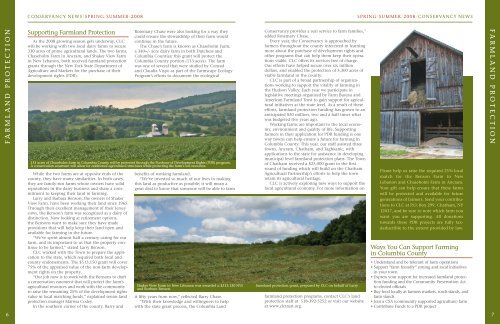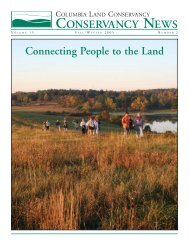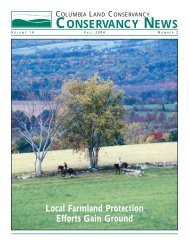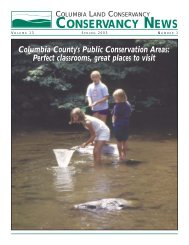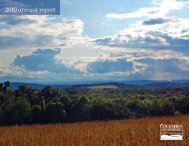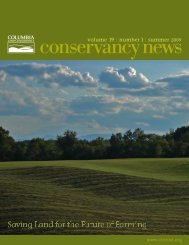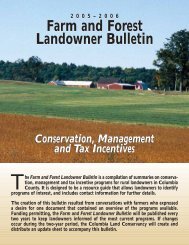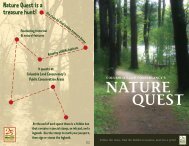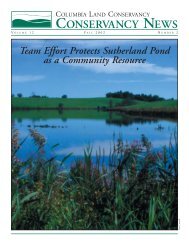Spring 2008 - Columbia Land Conservancy
Spring 2008 - Columbia Land Conservancy
Spring 2008 - Columbia Land Conservancy
You also want an ePaper? Increase the reach of your titles
YUMPU automatically turns print PDFs into web optimized ePapers that Google loves.
CONSERVANCY NEWS/SPRING/SUMMER/<strong>2008</strong><br />
SPRING/SUMMER/<strong>2008</strong>/CONSERVANCY NEWS<br />
C O N S E R VA T I O N E A S E M E N T S<br />
Protecting New Lebanon’s Character,<br />
One Property at a Time<br />
The northeast corner of <strong>Columbia</strong> County is rich in<br />
cultural and natural history. New Lebanon was home<br />
to one of the largest and most vibrant Shaker communities<br />
throughout the 19th century and the Shaker<br />
name has been given to a 495-acre wetland system<br />
which is home to a variety of rare plants. With all<br />
this local history, Helen Burton and Tod<br />
Houghtlin felt a deep sense of responsibility<br />
when it came to making decisions<br />
for their 181-acre property.<br />
“For Tod and me, placing a conservation<br />
easement on our property<br />
was a way to show the respect we<br />
feel for the landscape around us,”<br />
commented easement donor Helen<br />
Burton. “We are thankful that we<br />
can pass this special place on to<br />
those who follow us."<br />
Located on Canaan Road in New<br />
Lebanon, their property is what many<br />
think of as the classic <strong>Columbia</strong> County property:<br />
an historic farmhouse with open meadows and<br />
woodlands rising to the ridgeline. The hay fields,<br />
stonewalls, and hedgerows on the property indicate an<br />
agricultural heritage. The steep slopes and woodlands<br />
climbing up the ridgeline provide important wildlife<br />
habitat and drain into the Shaker Swamp, just across<br />
Route 22. The property is also visible from the Mount<br />
Lebanon Shaker Society National Historic <strong>Land</strong>mark.<br />
“When we accept a conservation easement, it is<br />
important that we can document that by conserving it,<br />
we will be protecting resources with conservation<br />
value and providing a benefit to the public,” noted<br />
Tony Colyer-Pendás, CLC’s Director of Conservation<br />
Programs. “The Burton property clearly warranted protection<br />
because of its visibility from public roads and<br />
Mount Lebanon, and its relationship to the ecological<br />
communities associated with the Shaker Swamp and<br />
surrounding Taconic Ridge.”<br />
The Town of New Lebanon has also<br />
recognized the value of protecting properties<br />
such as the Burton’s. Among the<br />
objectives of its recently adopted comprehensive<br />
plan is to “Preserve scenic<br />
vistas of the area’s natural beauty<br />
including vistas of woodlands, fields,<br />
ridgelines, hillsides, hilltops, and valleys.”<br />
The conservation easement on<br />
this property will help the town achieve<br />
these goals by limiting residential<br />
development to the existing house site and<br />
a second reserved site which is clustered close<br />
by, leaving the majority of the property open.<br />
The easement is part of a “Neighborhood<br />
Conservation Block” that is comprised of five other<br />
protected properties in close proximity totaling<br />
approximately 540 acres. Collectively, these properties<br />
contribute to the protection of the scenic<br />
landscapes that help define New Lebanon’s rural<br />
character, while protecting important wildlife habitat<br />
and local water quality.<br />
Helen Burton and Tod Houghtlin have protected 181 acres in New Lebanon with a conservation easement. The conservation of this property<br />
will help buffer the Mount Lebanon Shaker Society National Historic <strong>Land</strong>mark and Shaker Swamp from incompatible development.<br />
174-acre Easement in Austerlitz<br />
Protects Ridgeline Along Route 22<br />
The hamlet of Austerlitz lies in a valley carved by the<br />
Green River and flanked by the wooded slopes of the<br />
Taconics. Historically, people settled in the valley,<br />
taking shelter from winter winds, and relied on the rich<br />
bottomland soils to grow their crops. In more recent<br />
times, development has pushed up the ridgelines to<br />
capture the sweeping views afforded by those building<br />
in prominent locations.<br />
A174-acre conservation easement along Route 22 in Austerlitz<br />
will help protect the area’s rural character.<br />
Not all landowners subscribe to this approach to<br />
land development. CLC recently received a 174-acre<br />
easement donation from Jim Murray and Eleanor<br />
Saunders, protecting a highly prominent ridgeline<br />
along Route 22 near Harvey Mountain. The easement<br />
property also contains frontage along the Green River.<br />
“Ridgelines are important, not only scenically, but<br />
also for wildlife. Many species, including bear and bobcats,<br />
use ridges as migration corridors to move around,”<br />
notes CLC’s Marissa Codey.<br />
The proximity of this conservation easement to<br />
Harvey Mountain State Forest and a 542-acre easement<br />
donated to CLC in 2005 helps create a larger block of<br />
conservation land, improving the wildlife habitat value.<br />
“We chose not to reserve any future residential<br />
development on this parcel,” remarked landowner<br />
Eleanor Saunders. “We have another adjacent parcel<br />
where we can build, and felt that conservation was<br />
the best plan for the ridge.”<br />
As with all conservation easements, the property will<br />
remain on the tax rolls. Owners of conserved land may<br />
receive a tax credit from New York State, but it is up<br />
to each assessor to determine the appropriate tax assessment<br />
for parcels subject to a conservation easement.<br />
Chatham Family Conserves Farm<br />
Highland Farm on Highland Road is a Chatham landmark.<br />
Home to the Behrens family since 1946, its<br />
rolling hills and wooded trails have been well known<br />
for generations first as a dairy farm, and more recently<br />
as a sheep and horse farm. The family has now donated<br />
a second conservation easement to CLC as a means<br />
of conserving the core of the property prior to selling<br />
it to new owners.<br />
This 88-acre easement lies across the road from an<br />
86-acre parcel protected with an easement in 2003. The<br />
new easement protects two prominent ridgetop fields,<br />
a DEC regulated wetland, and a tributary to the Stony<br />
Kill, all within a stone’s throw from the Ooms<br />
Conservation Area at Sutherland Pond.<br />
As Director of Conservation Programs, Tony Colyer-<br />
Pendás, explained, “This transaction was quite complicated.<br />
It involved the transfer of the property out of the<br />
family over a period of several years. We worked with<br />
Wini Behrens, her daughter Gail, their advisors, and<br />
the new owners of the property to structure the deal.”<br />
The terms of the easement reflect the agricultural<br />
nature of the property, and are written to give future<br />
farm operators the flexibility they need when it comes<br />
to placing agricultural infrastructure on the landscape.<br />
In keeping with CLC’s view of recognizing <strong>Columbia</strong><br />
County as a “working landscape”, the easement will<br />
allow for any type of agriculture, as well as sustainable<br />
timber harvest.<br />
Important agricultural resources are being protected by a second<br />
conservation easement on Highland Farm in Chatham.<br />
“It was not an easy decision to sell the farm, but the<br />
conservation easements give us some peace of mind<br />
that the property’s essential character will remain,”<br />
stated Gail Day.<br />
C O N S E R VA T I O N E A S E M E N T S<br />
4<br />
5


